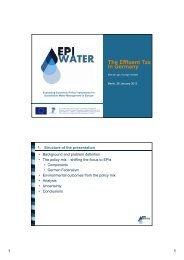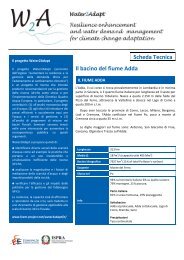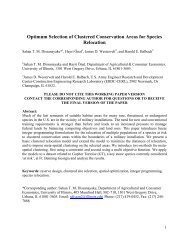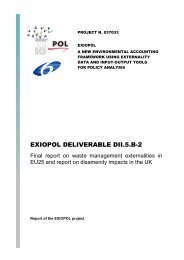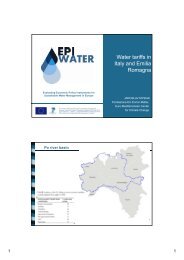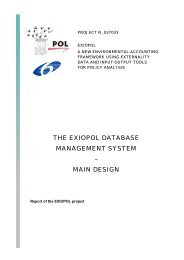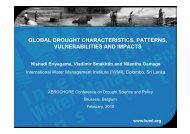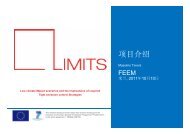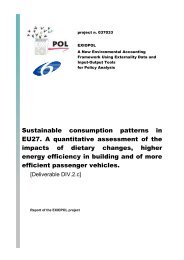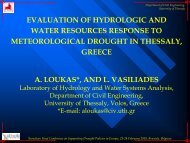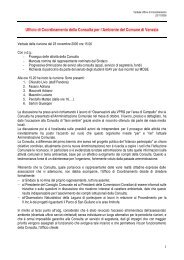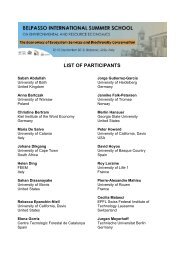Gulf and European Energy Supply Security - Feem-project.net
Gulf and European Energy Supply Security - Feem-project.net
Gulf and European Energy Supply Security - Feem-project.net
You also want an ePaper? Increase the reach of your titles
YUMPU automatically turns print PDFs into web optimized ePapers that Google loves.
partner countries aiming at facilitating investment<br />
in infrastructure that may reduce vulnerabilities <strong>and</strong><br />
the danger of accidents <strong>and</strong> engage in promotion<br />
endnotes<br />
1.<br />
2.<br />
3.<br />
4.<br />
5.<br />
6.<br />
7.<br />
8.<br />
9.<br />
Threats to Oil <strong>Supply</strong> <strong>Security</strong><br />
of international compacts to enforce ever more<br />
stringent st<strong>and</strong>ards for oil, products <strong>and</strong> chemical<br />
tankers.<br />
International <strong>Energy</strong> Agency, “IEA Response System for Oil <strong>Supply</strong> Emergencies,” December 2008, 11.<br />
Financial Times, April 2008.<br />
“Network Oil Infrastructures - An Assessment of the Existing <strong>and</strong> Planned Oil Infrastructures within <strong>and</strong><br />
towards the EU,” Commission Staff Working Document accompanying the Green Paper “Towards a<br />
Secure, Sustainable <strong>and</strong> Competitive <strong>European</strong> <strong>Energy</strong>,” COM(2008) 737.<br />
Caitlin Talmadge, “Closing Time: Assessing the Iranian Threat to the Strait of Hormuz,” International<br />
<strong>Security</strong> 33, no. 1 (Summer 2008): 82–117.<br />
Talmadge, ibid.<br />
US Congress, Joint Economic Committee, “The Strait of Hormuz <strong>and</strong> the Threat of an Oil Shock”, July<br />
2007 available at http://www.house.gov/jec/studies/2007/Straight%20of%20Hormuz%20Study.pdf<br />
The pipeline has been operating at much less than its rated maximum capacity because most customers<br />
of Saudi Aramco prefer to lift from Ras Tanura in the <strong>Gulf</strong> rather than from Yanbu. Nevertheless, a<br />
study conducted for the Baker Institute of Public Policy (Ewell, Brito <strong>and</strong> Noer An Alternative Pipeline<br />
Strategy in the Persian <strong>Gulf</strong>, http://www.rice.edu/energy/publications/docs/TrendsinMiddleEast_<br />
AlternativePipelineStrategy.pdf) concluded that “the throughput of the existing pipeline system can<br />
be significantly increased with the use of drag reduction technology. As many as 11 MBD could be<br />
moved through the combined Petroline-IPSA system for an investment of $600 million. Alternately,<br />
a noticeable increase in Petroline throughput can be obtained for as little as $100 million. All options<br />
require an additional annual cost of roughly $50 million to hold DRA (drag reduction agent) inventory, or<br />
additional investment to build DRA production capacity in Saudi Arabia. The additional cost of moving<br />
oil during a crisis by this route is less than $1 per barrel. This is clearly economically feasible in the event<br />
of a SoH (Strait of Hormuz) closure; the price of oil will rise more than $1 per barrel in this case, covering<br />
the additional costs. It is just as clearly not economically viable as a routine peacetime alternative: Yanbu<br />
exports are already economically unattractive (compared to Ras Tanura) for most Saudi customers, <strong>and</strong><br />
adding DRAs would increase costs of oil at Yanbu even further.”<br />
This discussion is based on Sam Bateman, Joshua Ho <strong>and</strong> Mathew Mathai, “Shipping Patterns in the<br />
Malacca <strong>and</strong> Singapore Straits: An Assessment of the Risks to Different Types of Vessel,” Contemporary<br />
Southeast Asia 29, No. 2 (2007):309–32.<br />
Sam Bateman, Catherine Zara Raymond, Joshua Ho, Safety <strong>and</strong> <strong>Security</strong> in the Malacca <strong>and</strong> Singapore<br />
Straits — An Agenda for Action, Singapore: Institute of Defence <strong>and</strong> Strategic Studies, 2006.<br />
10. http://www.icc-ccs.org/index.php?option=com_content&view=article&id=30&Itemid=12<br />
11. The map is accessible at http://www.icc-ccs.org/index.php?option=com_fabrik&view=visualization&co<br />
ntroller=visualization.googlemap&Itemid=219<br />
12. http://www.itopf.com/<br />
13.<br />
“Study of Maritime Traffic Flows in the Mediterranean Sea” Regional Marine Pollution Emergency<br />
Response Centre for the Mediterranean Sea (REMPEC), July 2008.




